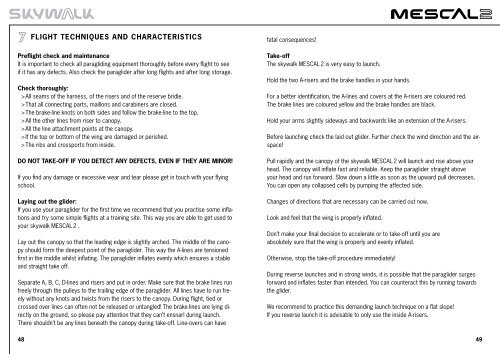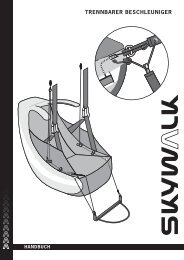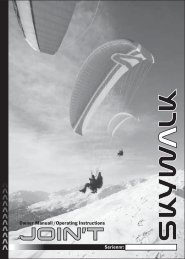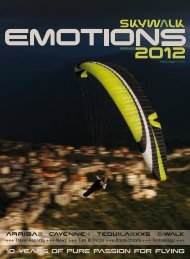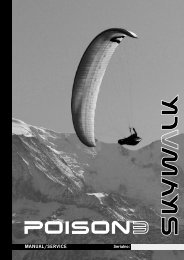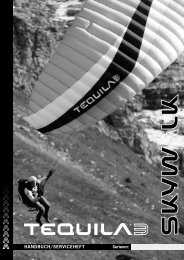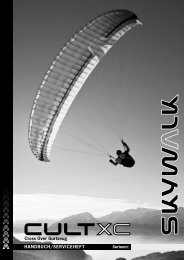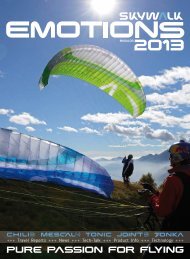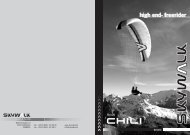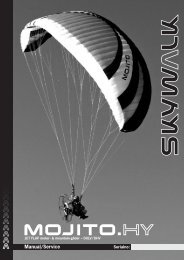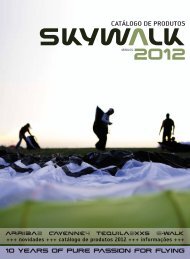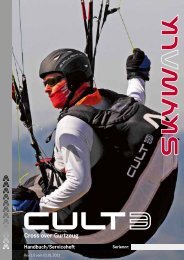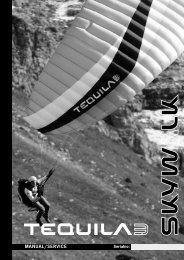mescal 2_e - Skywalk
mescal 2_e - Skywalk
mescal 2_e - Skywalk
You also want an ePaper? Increase the reach of your titles
YUMPU automatically turns print PDFs into web optimized ePapers that Google loves.
Flight Techniques and Characteristics<br />
Preflight check and maintenance<br />
It is important to check all paragliding equipment thoroughly before every flight to see<br />
if it has any defects. Also check the paraglider after long flights and after long storage.<br />
Check thoroughly:<br />
> All seams of the harness, of the risers and of the reserve bridle.<br />
> That all connecting parts, maillons and carabiners are closed.<br />
> The brake-line knots on both sides and follow the brake-line to the top.<br />
> All the other lines from riser to canopy.<br />
> All the line attachment points at the canopy.<br />
> If the top or bottom of the wing are damaged or perished.<br />
> The ribs and crossports from inside.<br />
Do not tAke-off IF YOU DETECT ANY DEFECTS, EVEN IF THEY ARE MINOR!<br />
If you find any damage or excessive wear and tear please get in touch with your flying<br />
school.<br />
Laying out the glider:<br />
If you use your paraglider for the first time we recommend that you practise some inflations<br />
and try some simple flights at a training site. This way you are able to get used to<br />
your skywalk MESCAL 2 .<br />
Lay out the canopy so that the leading edge is slightly arched. The middle of the canopy<br />
should form the deepest point of the paraglider. This way the A-lines are tensioned<br />
first in the middle whilst inflating. The paraglider inflates evenly which ensures a stable<br />
and straight take off.<br />
Separate A, B, C, D-lines and risers and put in order. Make sure that the brake lines run<br />
freely through the pulleys to the trailing edge of the paraglider. All lines have to run freely<br />
without any knots and twists from the risers to the canopy. During flight, tied or<br />
crossed over lines can often not be released or untangled! The brake-lines are lying directly<br />
on the ground, so please pay attention that they can’t ensnarl during launch.<br />
There shouldn’t be any lines beneath the canopy during take-off. Line-overs can have<br />
fatal consequences!<br />
Take-off<br />
The skywalk MESCAL 2 is very easy to launch.<br />
Hold the two A-risers and the brake handles in your hands.<br />
For a better identification, the A-lines and covers at the A-risers are coloured red.<br />
The brake lines are coloured yellow and the brake handles are black.<br />
Hold your arms slightly sideways and backwards like an extension of the A-risers.<br />
Before launching check the laid out glider. Further check the wind direction and the airspace!<br />
Pull rapidly and the canopy of the skywalk MESCAL 2 will launch and rise above your<br />
head. The canopy will inflate fast and reliable. Keep the paraglider straight above<br />
your head and run forward. Slow down a little as soon as the upward pull decreases.<br />
You can open any collapsed cells by pumping the affected side.<br />
Changes of directions that are necessary can be carried out now.<br />
Look and feel that the wing is properly inflated.<br />
Don’t make your final decision to accelerate or to take-off until you are<br />
absolutely sure that the wing is properly and evenly inflated.<br />
Otherwise, stop the take-off procedure immediately!<br />
During reverse launches and in strong winds, it is possible that the paraglider surges<br />
forward and inflates faster than intended. You can counteract this by running towards<br />
the glider.<br />
We recommend to practice this demanding launch technique on a flat slope!<br />
If you reverse launch it is advisable to only use the inside A-risers.<br />
48 49


